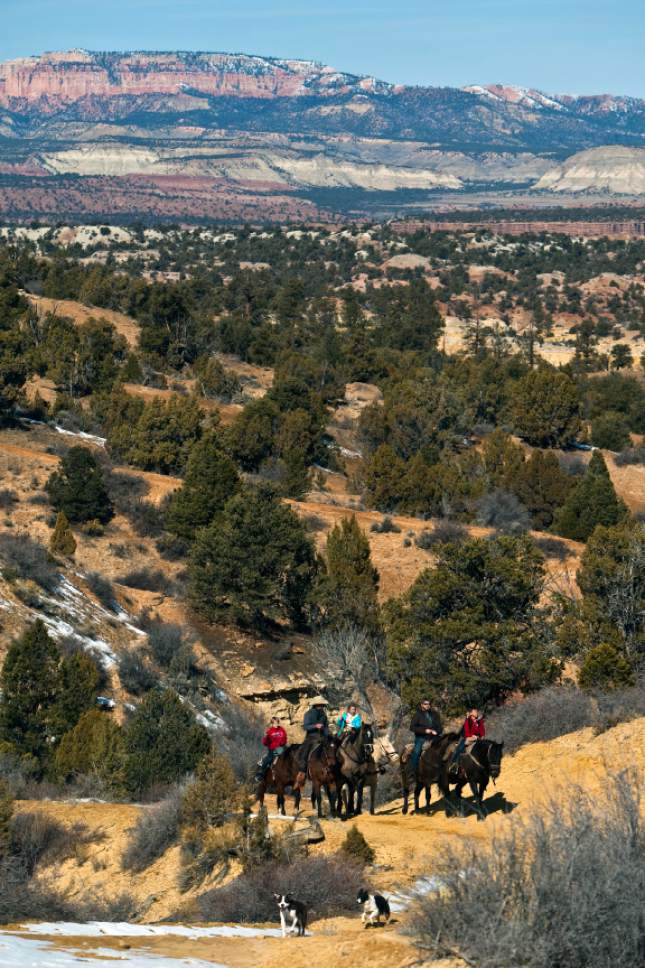This is an archived article that was published on sltrib.com in 2017, and information in the article may be outdated. It is provided only for personal research purposes and may not be reprinted.
Garfield County commissioners have hit the pause button on a proposed resolution targeting the Grand Staircase-Escalante National Monument after dozens of Boulder and Escalante business owners implored them to consider the monument's economic benefits before voting to drastically shrink it.
Business operators argue that the 1.9-million-acre monument, designated in 1996, drives a thriving and diverse economy, contrary to claims by elected leaders that it has sunk the county into a "state of emergency."
"They are always looking to coal, to timber; they are looking to the past rather than the future," said Boulder resident Lisa Varga, who operates the Burr Trail Outpost and Earth Tours guiding service with her husband, Keith Watts.
The County Commission, whose members past and present have argued monument regulations are strangling the county's customs and culture, agreed to hold a hearing March 13 before voting on whether to ask Congress to contract the Grand Staircase boundaries.
Varga estimated 75 people, mostly monument supporters, attended a meeting on the issue Tuesday, and many were puzzled that the commission would not make the resolution's text available, although it is thought to closely resemble resolutions passed recently by the Utah Legislature and the Kane County Commission. Officials indicated the text would be posted soon on Garfield County's website.
Messages left for County Attorney Barry Huntington and Commissioner Jerry Taylor, a former Escalante mayor, were not immediately returned.
The state and Kane County resolutions blame the monument for diminished grazing, energy development and road access, and for "a 44 percent reduction" in enrollment at Escalante High School — although the numbers cited, 151 to 67 students, indicate a 55.6 percent drop.
While traditional industries are declining in Garfield County, Escalante is experiencing a building boom and labor shortages thanks to an influx of businesses drawn by the region's stunning natural features, according to Nicole Croft, executive director of the nonprofit Grand Staircase Escalante Partners.
"Change is painful, but it doesn't mean that the monument has failed the community," said Croft, who was pleased commissioners delayed a vote on the resolution.
But other area officials see the issue differently.
The monument may help tourism-oriented business, but mostly at the expense of traditional Mormon residents who have relied on access to natural resources for their livelihoods, according to a former Bureau of Land Management planner Drew Parkin, who now serves Escalante in a volunteer capacity as economic development director.
Parkin agreed the monument attracts newcomers, but they are pushing property values out of reach for many Garfield County natives. The monument also indirectly led to the demise of the Steed family's sawmill, once Escalante's largest employer, by complicating timber harvests on the nearby Dixie National Forest.
"Establishment of [the monument] has resulted in loss of business opportunities and out-migration of families, workers and jobs," the Kane resolution and the Legislature's HCR12 state. "Boundary adjustments identified by Garfield and Kane counties are essential to the protection of the health, safety, welfare, prosperity, custom and commercial opportunities for their citizenry."
Officials, however, said neither county has sorted out which lands should be removed from the monument, which is administered by the BLM.
"We are still talking about the process for how we sit down and discuss it," said Brian Bremner, Kane County's public-lands director.
The resolutions direct the two counties to consult with the BLM and "create mapping of the minimum acreage necessary to protect antiquities identified" in the proclamation President Bill Clinton signed creating the monument.
Garfield County Commissioner Leland Pollack told lawmakers last week the monument should zero in on the Escalante canyons and a few other geological wonders, and a 500,000-acre footprint should suffice to meet the goals of the proclamation. He argued the Kaiparowits Plateau, which holds vast deposits of both coal and dinosaur bones, lacks the scenic qualities to justify inclusion in the monument, most of which he says is not much different than BLM rangelands elsewhere.
Some argue the desolate Kaiparowits should be preserved for its world-class paleontological resources, which are advancing dinosaur science, but Rep. Mike Noel, the sponsor of HCR12, says it should be tapped for coal worth hundreds of billions of dollars.
Escalante business leaders remain frustrated with what they see as a lack of transparency behind the resolution.
"That is one of the biggest issues. They are not telling us what they want to do," said Nate Waggoner, a guide whose family operates Escalante Outfitters. "It could backfire on them if they are not clear about what they are doing."
Twitter: @brianmaffly



